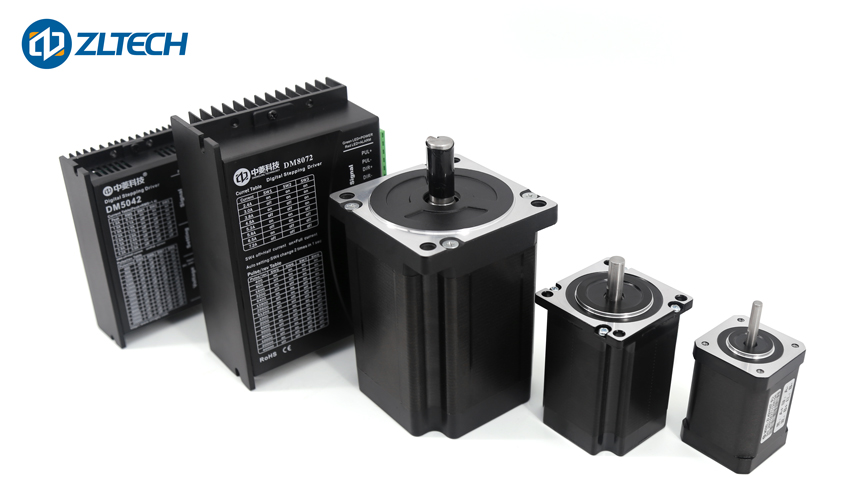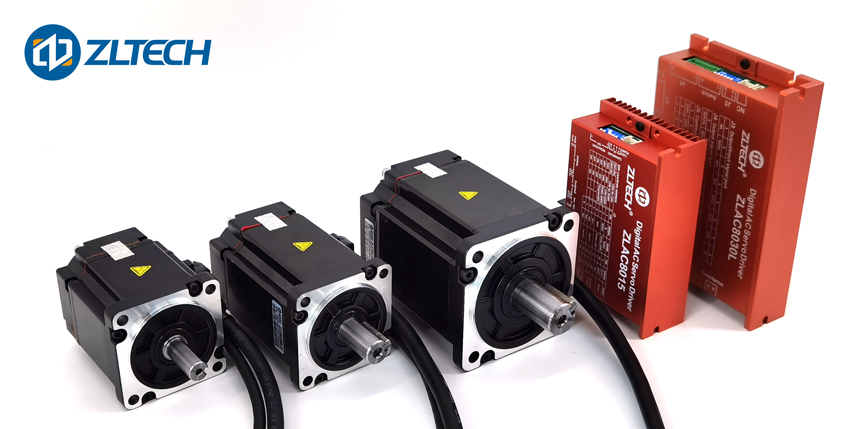1.On the Internet, people often ask, what is the difference between a stepper motor, a servo motor and a steering gear?
(1) Stepper motor is an open-loop control element stepper motor that converts electrical pulse signals into angular displacement or linear displacement. It is an induction motor. In the case of non-overload, the speed and stop position of the motor only depend on the frequency and number of pulses of the pulse signal, and are not affected by the load change. When the stepper driver receives a pulse signal, it drives the stepper motor. The set direction is rotated by a fixed angle, called “step angle”, and its rotation is performed step by step at a fixed angle. The angular displacement can be controlled by controlling the number of pulses, so as to achieve the purpose of accurate positioning. At the same time, the speed and acceleration of the motor rotation can be controlled by controlling the pulse frequency, so as to achieve the purpose of high speed. But there is no feedback signal, the motor does not know where it is, and the position accuracy is not high enough. 
(2) Servo motor refers to the engine that controls the operation of mechanical components in the servo system, and is an auxiliary motor indirect speed change device. The servo motor also controls the number of pulses. Each time the servo motor rotates an angle, it will send out a corresponding number of pulses. At the same time, the driver will also receive the feedback signal, which is compared with the pulse received by the servo motor, so that the system will know that the pulse is sent. How many pulses are sent to the servo motor and how many pulses are received at the same time, the rotation of the motor can be controlled very accurately, so as to achieve precise positioning, which can reach 0.001mm. The accuracy of the servo motor is determined by the accuracy (number of lines) of the encoder, that is to say, the servo motor itself has the function of sending out pulses. Every time it rotates an angle, it will send out a corresponding number of pulses, so that the pulses of the servo drive and the encoder of the servo motor are formed. It echoes, so it is closed-loop control, and the stepper motor is open-loop control. 
(3) The so-called steering gear is actually a low-end servo motor system, and it is also the most common servo motor system. The steering gear refers to an executive component that controls the rotation of the aircraft rudder surface (control surface) in the autopilot. It is divided into: ① Electric steering gear, which is composed of electric motor, transmission parts and clutch. It works by receiving the command signal of the autopilot. When the aircraft is manually piloted, the transmission parts do not work because the clutch remains disengaged. ②The hydraulic steering gear consists of a hydraulic actuator and a bypass valve. When the aircraft is manually piloted, the bypass valve is opened, and the hydraulic pressure on both sides of the actuator piston is connected to each other without hindering the manual operation. In addition, there are electro-hydraulic steering gear, referred to as “electro-hydraulic steering gear”
2.Second, the difference between stepper motor and servo motor is:
(1) Different workflow
Stepper Motor: Workflow Generally, two pulses are required for stepper motor work: signal pulse and direction pulse.
Servo motor: Its workflow is a power connection switch, and then connect the servo motor.
(2) Different low frequency characteristics
Stepper motor: low frequency vibration is prone to occur at low speed. When the stepping motor works at low speed, damping technology should generally be used to overcome the low-frequency vibration phenomenon, such as adding a damper to the motor, or using subdivision technology on the driver.
Servo motor: runs very smoothly and does not vibrate even at low speed.
(3) Different moment-frequency characteristics
Stepper motor: The output torque decreases with the increase of the speed, and it will drop sharply at a higher speed, so the maximum working speed is generally 300 ~ 600r/min.
Servo motor: It is constant torque output, that is, within its rated speed (generally 2000 or 3000 r/min), it outputs rated torque, and above the rated speed, it is constant power output.
(4) Different overload capacity
Stepper motors: generally do not have overload capacity. Because the stepping motor does not have such overload capacity, in order to overcome this inertia moment, it is often necessary to select a motor with a larger torque, and the machine does not need such a large torque during normal operation, so the torque appears. wasteful phenomenon.
Servo motor: has a strong overload capacity. Has speed overload and torque overload capabilities. Its maximum torque is three times the rated torque, which can be used to overcome the inertial moment of inertial load at the moment of starting.
(5) Different operating performance
Stepper motor: The control of stepper motor is open-loop control. If the starting frequency is too high or the load is too large, it is easy to lose steps or stall. When the speed is too high, it is easy to cause overshoot. Therefore, in order to ensure its control accuracy , should deal with the problem of speed up and down.
Servo motor: The AC servo drive system is closed-loop control, the driver can directly sample the feedback signal of the motor encoder, and the internal position loop and speed loop are formed. Generally, the phenomenon of step loss or overshoot of the stepping motor does not occur, and the control performance is better. to be reliable.
(6) Different speed response performance
Stepper motor: It takes 200 ~ 400m/s to accelerate from static to working speed (usually several hundred revolutions per minute).
Servo motor: The acceleration performance of the AC servo system is good, from static acceleration to its rated speed of 3000 r/min. It only needs a few m/s, and can be used for control fields that require fast start and stop and high positional accuracy.
Shenzhen Zhongling Technology Co., Ltd. has been focusing on the research of stepper motor and servo motor since its establishment, and has obtained a number of patents and has rich experience. The stepping motors and servo motors produced by the company are also sold at home and abroad, becoming the best choice for many robot companies and many automation equipment manufacturing companies.
Post time: Jan-03-2023
